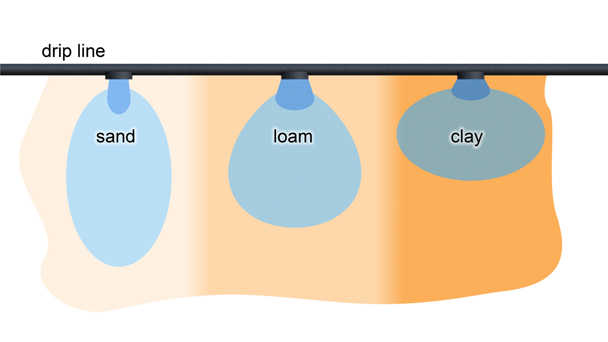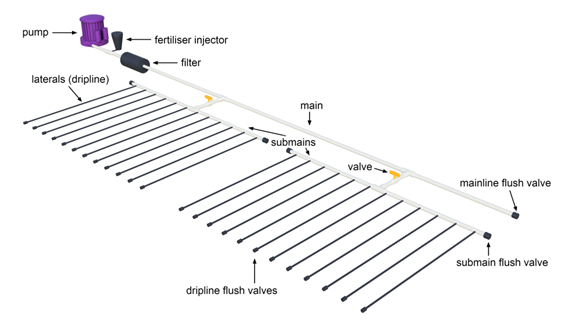Drip irrigation systems use small-diameter tubes placed above or below the soil’s surface. These systems are generally used in orchards, vineyards, or high-valued vegetable crops. Here we are going to highlight some aspects to consider when planning a drip irrigation system.
Water quality
Regardless of the irrigation method, all irrigators should be aware of their irrigation water quality to ensure that it is compatible with the crop and soil. Drip irrigators must know their water quality, as some water sources can create system blockages.
If there is uncertainty about existing water quality, a water analysis should be conducted. A complete water analysis will provide a water quality baseline and help identify the type and level of filtration and possible disinfestation practices needed for the water source.
Soil type and variation
A soil survey is essential for understanding relevant soil characteristics for irrigation. It classifies soils based on texture and depth, providing valuable information for designing the irrigation system layout.

Figure 1. Dripper wetted patterns in different soil types.
Designing the irrigation system according to soil type will help achieve even growth, maturity, yield and fruit quality, allowing efficient irrigation management. Each soil type and variety can be irrigated according to its requirements.
Irrigation system design
A correctly designed irrigation system is essential. Experience has shown that systems are more likely to be successful if designed appropriately, installed correctly, and managed well. If these aspects are ignored, production potential may not be reached. Contact a certified irrigation designer to secure your investment – check one in your area on Irrigation Australia.

Figure 2. Typical surface drip system layout
Number of irrigations shifts
‘Irrigation shift’ refers to the arrangement or aggregation of selected irrigation unit(s) of an irrigation system delivering water at a particular time.
Regardless of the size of the block or the irrigation management program chosen (e.g. pulsing), establishing whether an irrigation system will meet the peak water requirement of a crop can be achieved by determining the maximum number of shifts a system can run. This is a more critical question for drip irrigation than full cover sprinkler systems, due to drip systems having a lower application rate (full cover equivalent), therefore requiring a relatively longer run time to meet crop water requirements.
Emitter selection
The emitter – or dripper – is the device attached to the drip line or lateral to control the rate of water discharge from the lateral. It is important to choose the right emitter for the irrigation system.
When selecting an emitter, the main properties to consider are:
- Pressure compensating or non-pressure compensating.
- Type of dripper, and specialty function, such as non-drain (ND)
- Dripper quality, including manufacturing characteristics and susceptibility to clogging.
- Dripper discharge and spacing.
Quick tips:
- Only the more durable (and generally more expensive) drippers and drip lines are suitable for perennial horticulture. Cheaper drip line is normally designed for single season use only, like vegetable crops.
Converting mature plantings
Converting mature trees or vines into drip irrigation can be challenging for some irrigators. The main issues arise from not adjusting irrigation management practices to the new system. For example, irrigators new to drip irrigation often must initially recognise that more frequent irrigations are required. When converting existing trees from full cover to drip irrigation, the key aim is to quickly encourage enough root growth in the soil volume wetted by the drippers to support the plant during peak water demand.
Quick tips:
- The best time to convert to drip irrigation is straight after harvest, giving the plant extra time to adapt to the new system without a crop to support it.
- An ample water supply is usually recommended in the first year after conversion to maximise lateral spread and leach accumulated salts.
- To encourage root growth within the wetted strip, applying soluble fertiliser through the irrigation system (that is, fertigate) early in the season is essential. It is generally recommended to use nitrogen and phosphorus fertilisers weekly throughout the first season of conversion.
- It is highly recommended that soil moisture monitoring be adopted simultaneously with the new drip system.
For more information and to dive deeper into drip irrigation systems visit Agriculture Victoria or Ask an expert.
This publication is provided solely for information purposes and no representation or warranty is made as to its quality, accuracy, completeness, suitability, or fitness for any particular purpose. You should make your own enquiries as to its appropriateness and suitability for your particular circumstances. The State of Victoria as represented by its Department Energy, Environment and Climate Change accepts no duty of care and disclaims all liability in relation to use of this publication.
